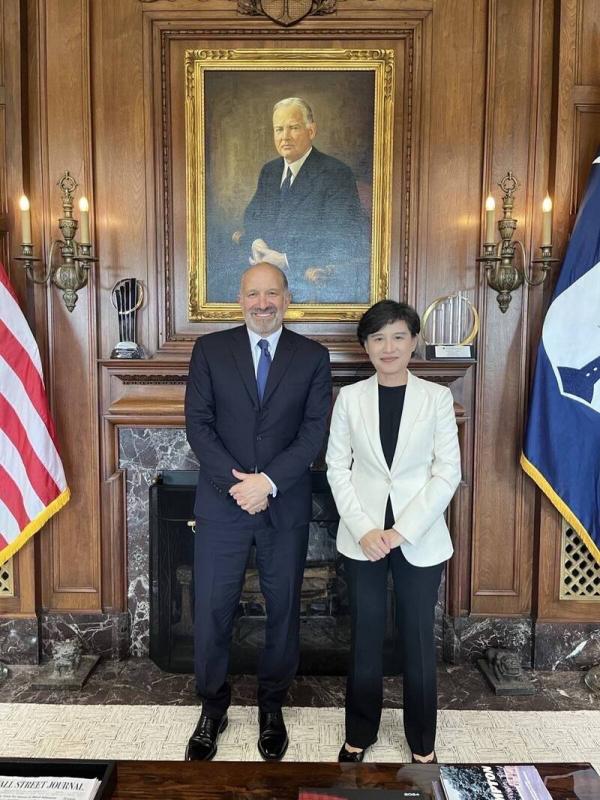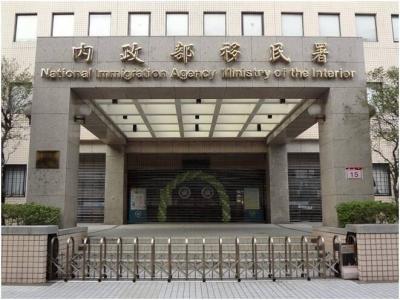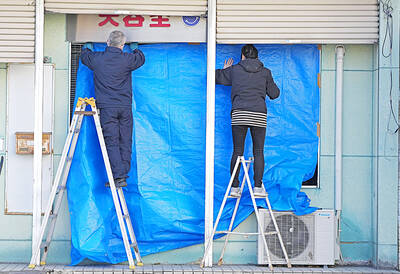The Executive Yuan today denied rumors that Taiwan’s tariff negotiating team was only holding discussions via video-call by releasing photos showing discussions taking place in-person.
Since the start of tariff negotiations, the US and Taiwan have held four rounds of in-person meetings, all of which took place at the office of the US Trade Representative starting at 9am and continuing late into the evening, the Executive Yuan’s Taiwan-US Economic and Trade Working Group said.
Each person attending must be approved by both sides, including chief negotiators and lawyers, the group said.

Photo courtesy of the Executive Yuan
Representative to the US Alexander Yui (俞大㵢) accompanied the team to the meetings, alongside experts and representatives from relevant ministries to discuss issues including tariffs, non-tariff trade barriers and economic resiliency, it said.
During each in-person meeting, Vice Premier Cheng Li-chiun (鄭麗君), the delegation’s leader, and Minister Without Portfolio Yang Jen-ni (楊珍妮), head of the Executive Yuan’s Office of Trade Negotiations, met with US Trade Representative Jamieson Greer for general discussions on key issues, the group said.
Cheng has also met with US Secretary of Commerce Howard Lutnick to discuss Section 232 tariffs, which authorize the US president to implement tariffs to protect national security, it said.
The delegation has also had joint meetings with Greer and Lutnick, it added.
Yang has held pre-session meetings with her US counterparts to discuss the meeting’s agenda, while Taiwanese and US officials would communicate outside meeting hours to discuss more technical issues and avoid disrupting the agenda, the group said.
Details of trade negotiations would not be revealed until after an agreement is finalized, it said.
The group explained that both sides are operating under a confidentiality agreement, agreeing not to disclose details so as to avoid influencing the outcome, although both sides do issue news releases that outline the scope of the meeting and individuals present.
This is the first time that photos of the meeting have been released to the public, it added.

A small number of Taiwanese this year lost their citizenship rights after traveling in China and obtaining a one-time Chinese passport to cross the border into Russia, a source said today. The people signed up through Chinese travel agencies for tours of neighboring Russia with companies claiming they could obtain Russian visas and fast-track border clearance, the source said on condition of anonymity. The travelers were actually issued one-time-use Chinese passports, they said. Taiwanese are prohibited from holding a Chinese passport or household registration. If found to have a Chinese ID, they may lose their resident status under Article 9-1

Taiwanese were praised for their composure after a video filmed by Taiwanese tourists capturing the moment a magnitude 7.5 earthquake struck Japan’s Aomori Prefecture went viral on social media. The video shows a hotel room shaking violently amid Monday’s quake, with objects falling to the ground. Two Taiwanese began filming with their mobile phones, while two others held the sides of a TV to prevent it from falling. When the shaking stopped, the pair calmly took down the TV and laid it flat on a tatami mat, the video shows. The video also captured the group talking about the safety of their companions bathing

PROBLEMATIC APP: Citing more than 1,000 fraud cases, the government is taking the app down for a year, but opposition voices are calling it censorship Chinese Nationalist Party (KMT) Chairwoman Cheng Li-wun (鄭麗文) yesterday decried a government plan to suspend access to Chinese social media platform Xiaohongshu (小紅書) for one year as censorship, while the Presidential Office backed the plan. The Ministry of the Interior on Thursday cited security risks and accusations that the Instagram-like app, known as Rednote in English, had figured in more than 1,700 fraud cases since last year. The company, which has about 3 million users in Taiwan, has not yet responded to requests for comment. “Many people online are already asking ‘How to climb over the firewall to access Xiaohongshu,’” Cheng posted on

A classified Pentagon-produced, multiyear assessment — the Overmatch brief — highlighted unreported Chinese capabilities to destroy US military assets and identified US supply chain choke points, painting a disturbing picture of waning US military might, a New York Times editorial published on Monday said. US Secretary of Defense Pete Hegseth’s comments in November last year that “we lose every time” in Pentagon-conducted war games pitting the US against China further highlighted the uncertainty about the US’ capability to intervene in the event of a Chinese invasion of Taiwan. “It shows the Pentagon’s overreliance on expensive, vulnerable weapons as adversaries field cheap, technologically